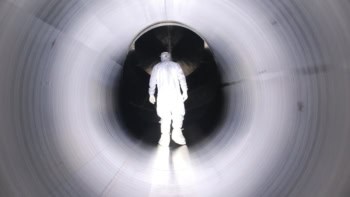More than 1000 nuclear physicists are striving to avoid a split in the community over the next generation of heavy-ion experiments.
The dispute centres around European contributions to the relativistic heavy-ion collider (RHIC) at the Brookhaven National Laboratory in the US and American contributions to a large ion collider experiment (ALICE) at CERN, the European particle physics laboratory in Geneva. Each side wants the other to participate more fully in its experimental programme – but there are problems with funding and timing.
Both experiments seek to recreate the primordial “soup” of particles than existed immediately after the big bang and from which everyday matter condensed out. Today quarks only exist inside strongly interacting particles, called hadrons, where they are held together by gluons. By colliding two beams of relativistic heavy ions, the physicists hope to create matter with an energy density so high that the quarks and gluons will co-exist as a plasma.
To study this, US physicists have built RHIC. When completed in 1999, it will collide gold ions at energies of 100 GeV per nucleon in each beam. The European ALICE experiment is one of the four detectors planned for the large hadron collider, which will be ready in 2005. Although both sides recognize the advantages in collaboration, obstacles remain.
Europe has contributed to the RHIC experiments at the 10-15% level through various national funding agencies. However, it was originally anticipated that Europe would contribute much more than this. “Historically, the European relativistic heavy-ion community played a leading role in the development of the field. Thus it was natural for the Americans to assume that RHIC would be the world centre and that the community – including the Europeans – would converge on it, ” says Peter Braun-Munzinger of the GSI laboratory in Darmstadt, Germany.
Meanwhile, R&D for the ALICE detector is due to finish at the end of 1998. At this stage, the major groups responsible for building the detector must be identified. However, this coincides with the start of experiments on RHIC and there are concerns that the US will not be able to commit at this stage. “RHIC has taken all of our resources to complete; we do not expect to be able to afford a significant contribution to ALICE until 2002-03, ” says Tom Ludlam of Brookhaven. “We have a very clear timetable for experiments but we do not have a timetable for collaboration, ” says Jürgen Schukraft, who is the ALICE spokesperson at CERN. Nevertheless, there may be a solution that satisfies both sides. Two more European projects on RHIC are under serious consideration, according to Schukraft. And if later funding for ALICE could be found by the US, he adds, the collaboration could get started with intellectual co-operation and perhaps a few $100 000 for R&D.
“I feel that there will be significant US and Japanese contributions to ALICE, ” says Braun-Munzinger. “I also believe strongly that we should leave the door open for a mechanism in which the US can jump into ALICE in 2000-01.”



